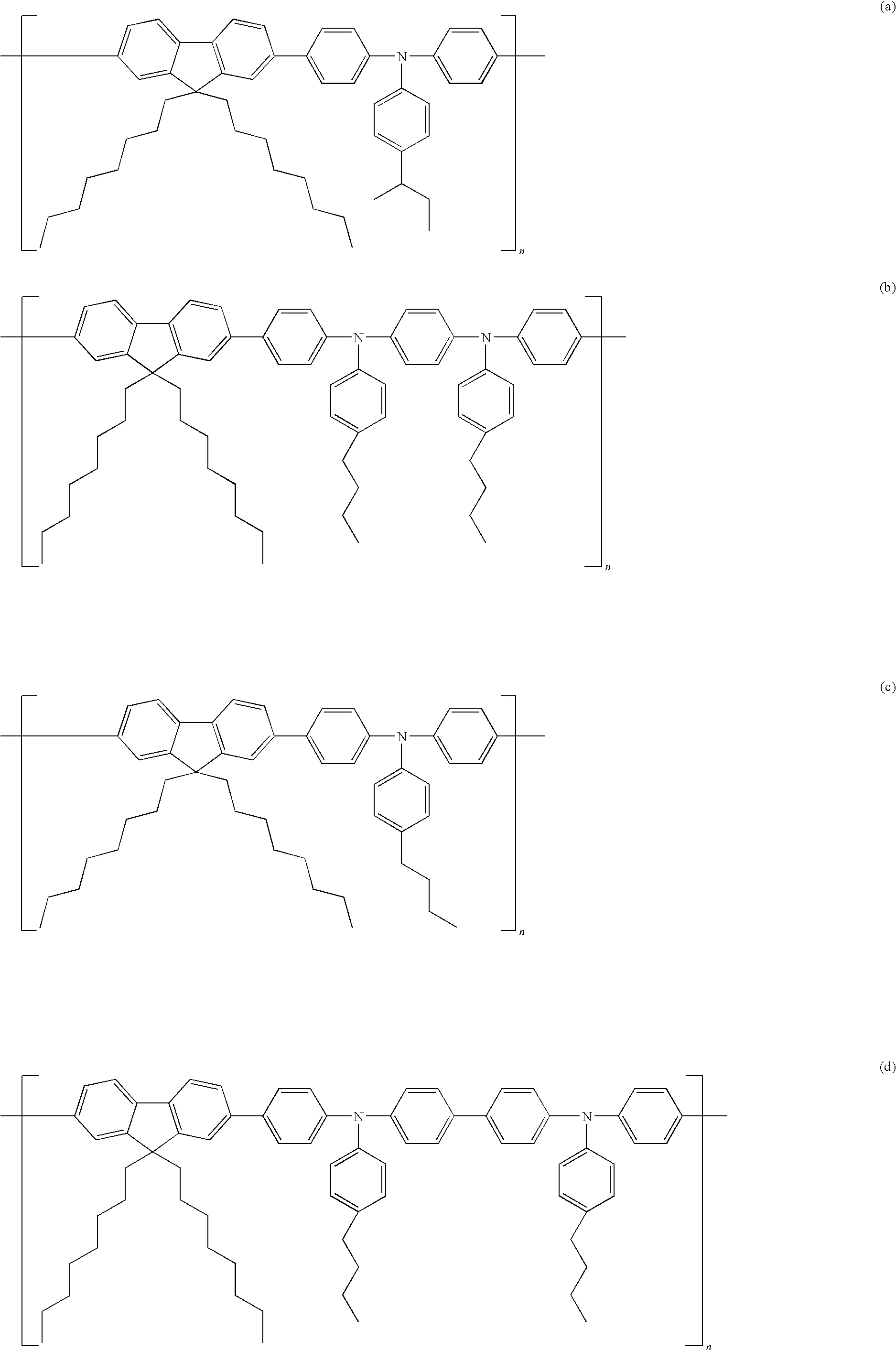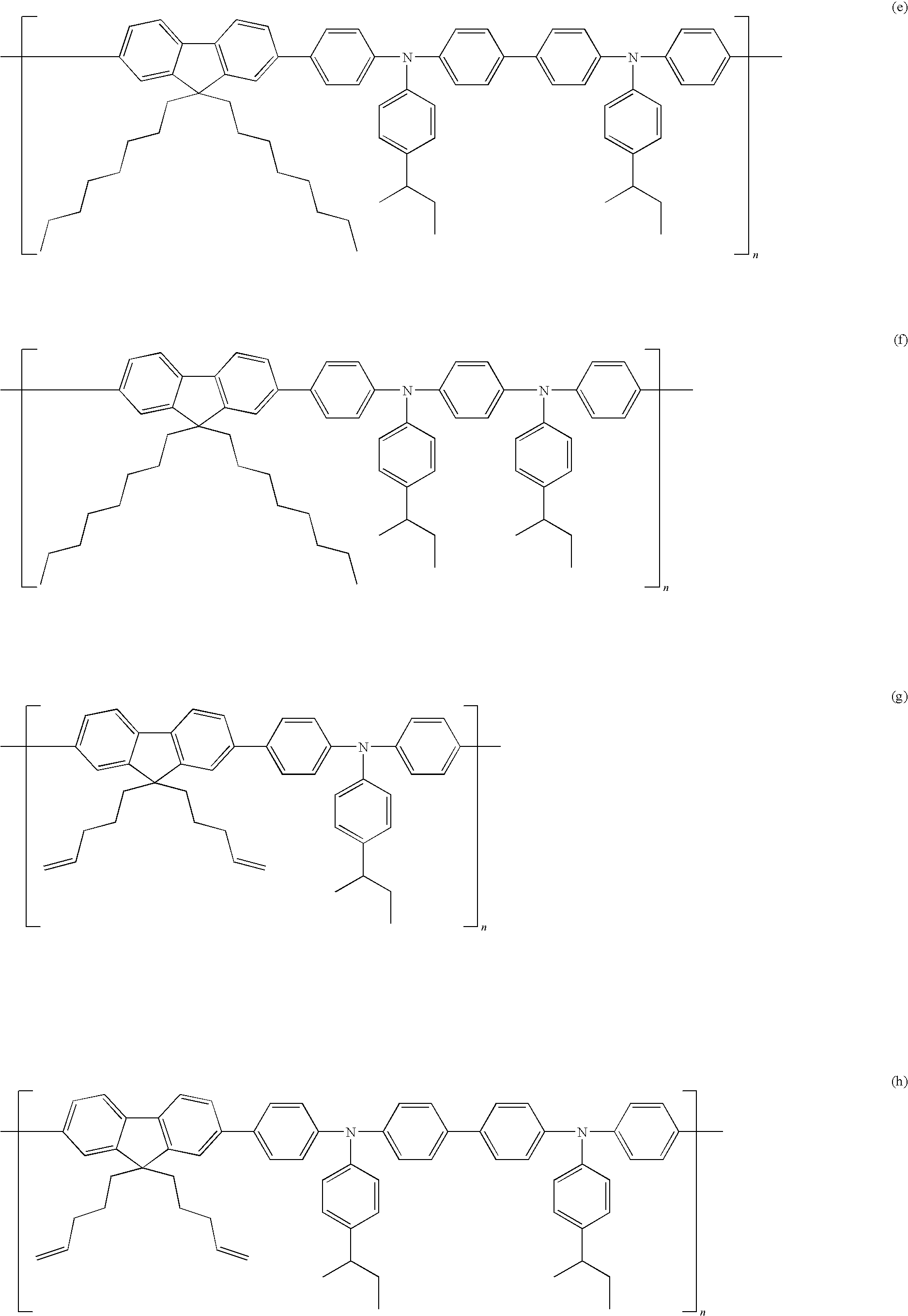Polymeric compound for organic electroluminescence and method for production thereof
a technology of organic electroluminescence and polymer compound, which is applied in the direction of discharge tube/lamp details, luminescent compositions, discharge tube luminescnet screens, etc., can solve the problems of insufficient reduction of light intensity with increasing driving time, inability to purify by sublimation, silica gel column and recrystallization, and inability to reduce bromides and iodides sufficiently by conventional methods, etc., to achieve the effect of improving the life of the resul
- Summary
- Abstract
- Description
- Claims
- Application Information
AI Technical Summary
Benefits of technology
Problems solved by technology
Method used
Image
Examples
synthesis example 1
[0075]A polymer compound of formula (a) was synthesized by the following method.
[0076]In an argon atmosphere, 9,9-dioctylfluoren-2,7-bis(trimethyleneborate) (3.6 g, 6.6 mmol), 4-sec-butylphenyl-di(4′-bromophenyl)amine (3.0 g, 6.6 mmol) and Pd(PPh3)4 (24 mg, 2 μmol) were dissolved in anhydrous THF / toluene (30 mL / 30 mL), 20 wt % Et4NOH (18 mL) was added and the mixture was stirred for two hours. Bromobenzene (0.6 g) was added to the resultant reaction solution and stirred for 1 hour. Phenylboronic acid (0.6 g) was further added and stirred for 1 hour.
[0077]The reaction solution was slowly dripped to methanol (1 L). A precipitated solid was filtered to obtain 3.3 g of a polymer compound of formula (a). The polymer compound had a number average molecular weight of 40500 and molecular weight distribution of 3.35. The Br content was measured by ICP-MS (combustion method) and found to be 580 ppm by mass.
synthesis example 2
[0078]The polymer compound synthesized in Synthesis Example 1 was dissolved in toluene. The solution was added to methanol. A precipitated solid was filtered. This process was repeated three times to purify the polymer compound. The Br content of polymer compound thus obtained was measured by ICP-MS (combustion method) and found to be 72 ppm by mass.
example 1
Grignard Reagent Treatment
[0079]In an argon atmosphere, 1 g of the polymer compound of formula (a) obtained in Synthesis Example 2 was dissolved in 50 ml of anhydrous tetrahydrofuran and 0.2 ml of a tetrahydrofuran solution of phenyl magnesium bromide (manufactured by Tokyo Kasei Kogyo Co., Ltd.) was gradually added dropwise thereto while cooling on ice, followed by stirring at 50 to 60° C. for 30 minutes. Dilute sulfuric acid was added to decompose unreacted materials. An organic layer was separated. After washing the organic layer with an aqueous sodium hydrogen carbonate solution and then with a saturated saline solution, the layer was concentrated under reduced pressure. The concentrated residue was purified by silica gel column chromatography (elution solvent: methylene chloride) to obtain 0.91 g of a yellow fibrous solid.
[0080]The Br content of polymer compound thus obtained was measured by ICP-MS (combustion method) and found to be 48 ppm by mass.
PUM
| Property | Measurement | Unit |
|---|---|---|
| reaction temperature | aaaaa | aaaaa |
| reaction temperature | aaaaa | aaaaa |
| reaction temperature | aaaaa | aaaaa |
Abstract
Description
Claims
Application Information
 Login to View More
Login to View More - R&D
- Intellectual Property
- Life Sciences
- Materials
- Tech Scout
- Unparalleled Data Quality
- Higher Quality Content
- 60% Fewer Hallucinations
Browse by: Latest US Patents, China's latest patents, Technical Efficacy Thesaurus, Application Domain, Technology Topic, Popular Technical Reports.
© 2025 PatSnap. All rights reserved.Legal|Privacy policy|Modern Slavery Act Transparency Statement|Sitemap|About US| Contact US: help@patsnap.com



